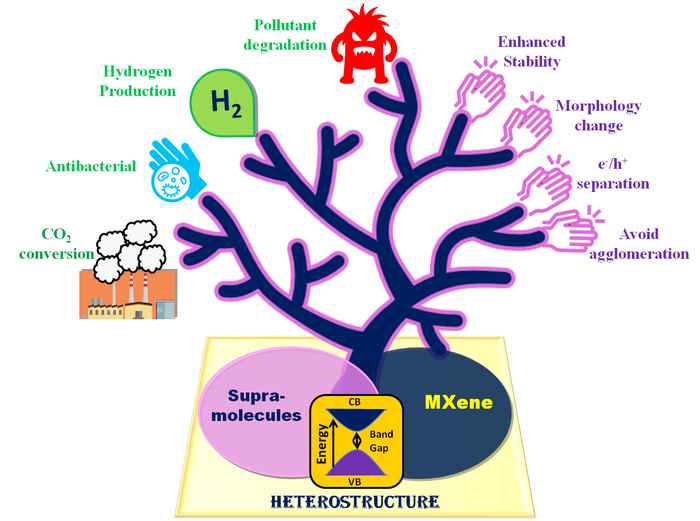The potential of supramolecular MXene heterostructures for photocatalytic application
19 June 2025

The review is a joint effort of postdoc researcher Dr Pankaj Verma and her advisors Dr Shiju Raveendran (Catalysis Engineering) and Prof. Jan H. van Maarseveen (Synthetic Organic Chemistry), with the support of Research Priority Area Sustainable Chemistry funding. It explores how the low thermal stability and chemical stability of supramolecules (which provide eco-friendly options for photocatalytic applications due to their tuneable porous structures and photophysical properties) could be counteracted by combining them with more stable materials like MXenes, thus forming heterostructures that enhance stability and improve photocatalytic activity.
The review places particular emphasis on the role of morphology and interfacial structure in governing charge carrier dynamics, stability, and recyclability. It also discusses how these properties can be tailored through various synthesis strategies, such as in situ fabrication and post-synthesis modification.
Looking ahead, the authors advocate for future research to focus on the development of new synthesis techniques that facilitate new bonding between composite materials and explore their performance in other applications. Overall, the integration of supramolecules with MXenes opens up new opportunities for the development of sustainable materials for photocatalytic applications, contributing to the solution of energy and environmental problems through green technology.
Abstract, as published in the paper
Recently, supramolecules have emerged as innovative and eco-friendly options for photocatalytic applications due to their tunable porous structures and photophysical properties. However, their low thermal stability and chemical stability pose a significant challenge. To address this, combining supramolecules with more stable materials like MXenes, which have a low Fermi energy level, is a useful strategy, in which they can form heterostructures that enhance stability and improve photocatalytic activity. The synthesis process, whether through in situ or post-synthesis modifications, plays a crucial role in controlling the formation of both covalent and non-covalent interactions, as well as the morphology of the heterostructures. These interactions and the resulting morphology significantly influence the recombination and separation of charge carriers (electron–hole pairs), ultimately affecting the stability and recyclability of the heterostructures in photocatalytic applications. In this review, we discuss the importance of supramolecule/MXene heterostructures, detailing their synthesis and morphology, as well as the mechanisms involved in various applications.
Paper details
Pankaj Verma, Jan H. van Maarseveen and N. Raveendran Shiju: Supramolecular structure@MXenes for photocatalytic applications – a review. Chem. Commun., 2025, 61, 7408-7425. DOI: 10.1039/D4CC06102K